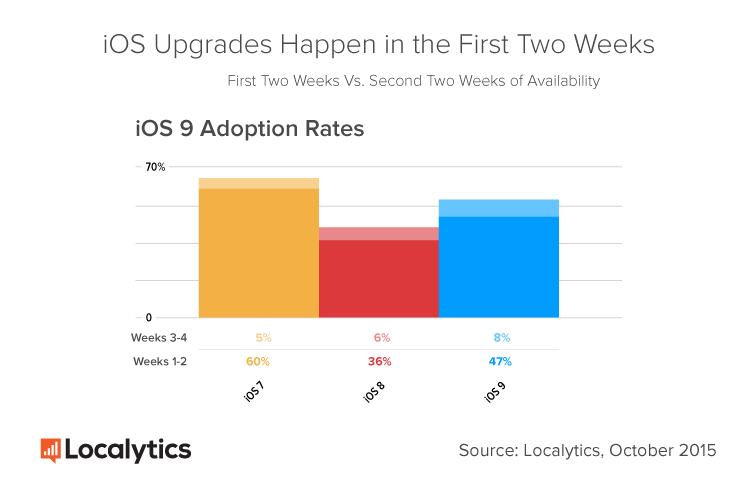It’s been one month since Apple released iOS 9, and much has been made about the various bugs in this version. We took a closer look to see if these bugs are affecting the adoption of iOS 9, as well as what the introduction of bug fix versions 9.0.1 and 9.0.2 has meant for the use of the original version. We also studied the adoption of iOS 9 by country to see if certain countries presented any specific issues.
iOS 9 Adoption Slowing Down
One month after the release of iOS 9, our data once again shows that iOS 9 has stronger adoption than iOS 8, but neither OS comes close to the adoption of iOS 7. Additionally, iOS 9 adoption is still strong at 55% but has significantly slowed down in the last two weeks of the month.

In the first two weeks of iOS 9’s availability, 47% of users had adopted it, whereas only 8% of users adopted it in weeks three and four. The early spike supports the notion that there are a fair number of tech enthusiasts who love the brand and are often quick to upgrade, whereas others will wait until the bugs work themselves out. And as you’ll see next, there have been plenty of bugs.
Bugs Results in Release of 9.0.1 and 9.0.2
Since iOS 9’s release, there have been numerous bugs and issues reported. The issues have been as dramatic as phones crashing to less dramatic, but equally frustrating, unavailability of app splicing. Other bugs included locking users’ screens and cellular access being cut off to third party apps.
Apple listened to their users and created not one but two OS bug fixes, 9.0.1 and 9.0.2. As a result, 69% of users on the new OS have already upgraded to a more stable version, validating the concern around bug issues.

The remaining 31% of users on the original release iOS 9 may be waiting until a major update comes out. And the good news is that is on its way, with version 9.1 currently in its 5th Beta with developers.
iOS 9 Strong in Europe, Weak in China
Lastly, it would seem overall adoption of Apple’s new OS is also being affected by restrictions in some countries. Even though China is a big phone market, it has the lowest adoption rate for iOS 9 at 36%. It’s been reported that Apple blocked China’s access to the News app with the iOS 9 update, so it’s possible that this feature has deterred users in China from upgrading to the version.
On the other end of the spectrum, European countries are adopting iOS 9 the fastest with Germany, Turkey and Italy’s adoption at 64%, 63% and 60%, respectively.

One last note: since our study analyzes all devices eligible for an OS upgrade, excluding iPhones that automatically included the new OS version on the device, we also looked into OS adoption by device to see if certain devices had an effect on adoption. However, we found that the share didn’t change from our update two weeks ago, so for that data, please visit our previous post.
What has your experience been with iOS 9? Let us know in the details below, and make sure to check out our blog next week for our 30 day update post of the iPhones.
Methodology
Localytics is the leading lifecycle engagement platform across more than 2.7 billion devices and 37,000 mobile and web apps. Localytics processes 120 billion data points monthly. For this study, we examined over 50 million iOS devices. The iOS report was created by analyzing all devices eligible for an OS upgrade, excluding iPhones that automatically included the new OS version on the device. For the country analysis, Localytics examined the 15 countries with the highest adoption rate who have access to iOS 9.
This article was syndicated from Business 2 Community: Are Bugs To Blame For the iOS 9 Adoption Slowdown?
More Technology & Innovation articles from Business 2 Community:





